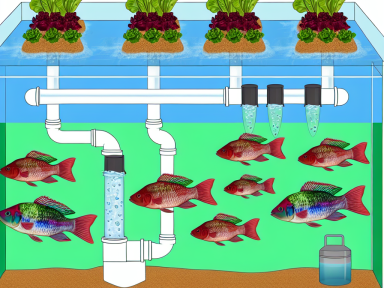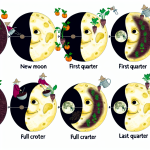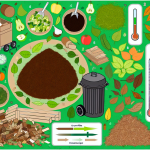Understanding Aquaponics: A Symbiotic System
Aquaponics combines aquaculture (raising aquatic animals) and hydroponics (growing plants in water) into a single, integrated system. The beauty lies in its efficiency and sustainability. Fish waste provides an organic nutrient source for plants, and plants help filter the water, creating a balanced, self-sustaining environment.
Components of an Aquaponics System
1. **Fish Tank**: This is where the fish live. Choose a size appropriate for the space you have and the number of fish you plan to raise.
2. **Grow Bed**: This is where plants grow. The grow bed should be positioned above the fish tank to allow gravity to help return filtered water to the fish.
3. **Pump**: A water pump circulates water from the fish tank to the grow bed and back.
4. **Grow Media**: Use lightweight, porous materials such as expanded clay pellets to support plant roots and facilitate bacterial growth.
5. **Plumbing**: Ensure efficient water flow between components using PVC pipes and fittings.
6. **Bacteria**: These microorganisms convert fish waste (ammonia) into nitrates, which plants use as food.
Choosing Fish and Plants
**Fish**: Select fish that are hardy and well-suited for your climate. Tilapia, trout, and catfish are commonly used due to their adaptability and quick growth rates.
**Plants**: Leafy greens like lettuce, spinach, and herbs are perfect for beginners. They have fast growth cycles and low nutrient demands. As you gain confidence, experiment with fruiting plants like tomatoes and peppers.
Setting Up Your Aquaponics System
1. **Assemble Your System**: Begin by setting up your fish tank, grow bed, and necessary plumbing. Ensure everything is securely connected to avoid leaks.
2. **Cycling the System**: Introduce water and allow the system to run without fish for a few weeks. This vital process, known as cycling, establishes beneficial bacteria colonies necessary for breaking down fish waste.
3. **Add Fish**: Once the water tests confirm stable ammonia, nitrite, and nitrate levels, introduce your chosen fish.
4. **Planting**: Begin by planting seedlings or young plants in the grow media. Space plants appropriately to avoid overcrowding.
Maintenance Tips
1. **Monitor Water Quality**: Regularly test water for pH, ammonia, nitrites, and nitrates. Optimal pH levels for aquaponics range from 6.8 to 7.0.
2. **Feed Fish Properly**: Overfeeding leads to excess waste, which can imbalance the system. Feed fish small amounts they can consume in a few minutes.
3. **Check Pump and Plumbing**: Ensure the water pump is working efficiently and the pipes are free from blockages.
4. **Organic Pest Control**: Use natural methods such as introducing beneficial insects or using neem oil to manage pests.
5. **Harvesting Plants**: Harvest plants as they mature. Continual harvesting encourages new growth and maintains a balanced ecosystem.
Troubleshooting Common Issues
1. **Algae Growth**: Excess algae can consume oxygen. Prevent it by covering fish tanks and reducing light exposure.
2. **Plant Yellowing**: This can indicate a nutrient deficiency. Check and balance the nutrient levels by adding organic supplements if necessary.
3. **Fish Health**: Stress in fish is often due to poor water quality. Regular water changes and monitoring can prevent diseases.
By integrating fish and plants into a single system, aquaponics offers an innovative, sustainable approach to food production. With patience, practice, and this guide, you’ll be well on your way to mastering the art of aquaponics in your backyard.



GIPHY App Key not set. Please check settings